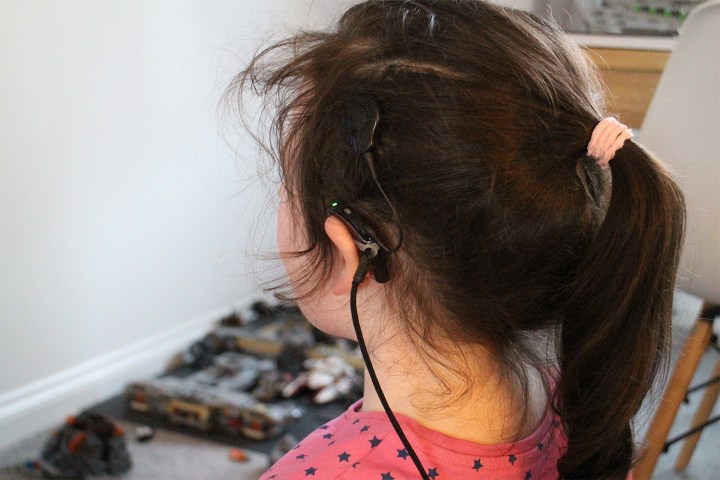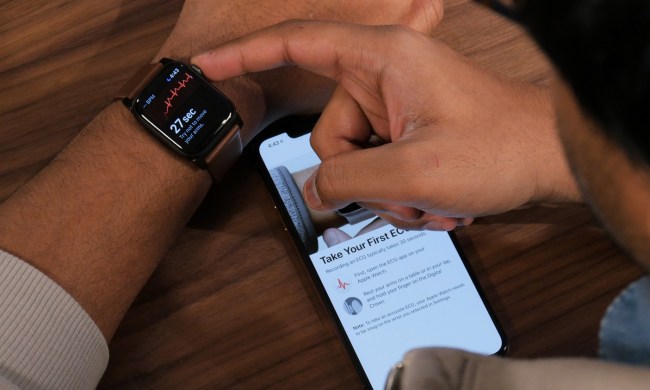
It wasn’t until my brother told me they were concerned that I noticed my niece couldn’t hear like other kids. When children are very young it can be extremely difficult to determine their level of hearing.
“Around her first birthday, we realized she wasn’t responding normally to sound,” Steven Hill told Digital Trends. “She didn’t react to a lot of sounds, and when she was sleeping it was very difficult to wake her.”
Because Maddie still had some hearing, it was a long struggle for her parents to get her diagnosed properly. Poor results in hearing tests are sometimes attributed to fidgety kids, and she was smart enough to compensate for her lack of hearing.
They tried hearing aids for a while, but they just amplify sound. If you can’t fundamentally hear certain frequency ranges, then a hearing aid can’t do anything for you. They taught her some sign language to make it easier for her to communicate. But once it became clear the hearing aids, even at the highest volume, weren’t helping, Maddie was finally diagnosed with profound hearing loss.
“If we didn’t implant when we did, it would have been removing a choice from her.”
The next step suggested was a cochlear implant, and because of the delay in her diagnosis, the doctors wanted to proceed with it as quickly as possible. If the brain’s auditory pathways aren’t stimulated in the first three to four years, then the capacity to hear and learn to speak normally can be dramatically reduced, because the brain focuses on other functions.
“We didn’t get as much time as we’d have liked to find out everything we wanted to,” Hill said. “Our overriding rationale was that if she decides later in life she doesn’t want to hear, and instead use sign, then she can remove them. But if we didn’t implant when we did, it would have been removing a choice from her.”
Cochlear implants
Although they’re generally seen positively, some people in the deaf community have reservations about cochlear implants, as this New York Times opinion piece explains. There’s also a risk that the operation won’t succeed, or that complications with infection might arise. While the cochlear implantation can be a two-hour per ear outpatient operation for adults, it’s not as simple with kids. Maddie had to get a general anesthetic and undergo an eight-hour operation.
“It was the longest day of our lives,” Hill said with a sigh. “The aftermath of the operation, the enormous head bandage, the upset, the inability to explain to her why we did it, and then Maddie signing that she had broken her head the first time she saw herself in a mirror – we wondered if we had done the right thing.”

While the surgeon was able to declare the operation a success, they would have to wait a further month for things to heal, before they could turn everything on and find out whether Maddie could hear sound.
“A small implant is placed under the skin right behind the ear and then an electrode is inserted into the cochlea,” Craig Sharp, product manager at Cochlear, told Digital Trends. “When sound is captured by the external processor piece, it’s then passed magnetically through the skin to the implant. All the acoustic sounds captured are transferred into electrical signals which stimulate the hearing nerve directly.”
Usually, sound enters the ear and thousands of tiny hairs stimulate the hearing nerve, but these hairs are often absent or damaged in people with hearing loss. With the cochlear implant, 22 electrodes fire in different combinations to replicate that sound with electrical signals. People with implants don’t hear like we do — there are limitations. Some studies suggest subtle differentiations in tone of speech or moods in music may be difficult for people with implants to discern.
Maddie calls the external apparatus “her ears” and if she gets tired or fed up, she takes them off.
Cochlear is an Australian company and it started implanting people back in the mid-eighties. There are more than 300,000 people worldwide with Cochlear implants today (around 96,000 of them in the U.S.), but the technology has evolved enormously over the years.
“One of the earliest systems was a huge box that you wore around your neck,” Sharp said. “We launched the latest version, Nucleus 7 with the mobile app in 2017.”
Every new version of the Cochlear system has folded in the latest advances in miniaturization and sound processing improvements, but Nucleus 7 is the first to take advantage of our smartphones. Cochlear worked closely with Apple to bring audio streaming support, so you can stream sound directly from your iPhone or iPad to the sound processor. This brings several important benefits.
“If you have hearing loss, talking on the phone has historically been really challenging. It’s hard to know how to orient the handset, and there’s a lot of signal loss between the phone and your hearing device,” Sharp said. “Bypassing that and streaming directly really improves the clarity, and allows people to talk on the phone in a way that many were unable to before.”

For people with family overseas, this is a game changer. It enables grandma to FaceTime with the kids, when before they may have only been able to talk directly face-to-face once a year. It also makes everyday life easier, from ordering a pizza to fixing an appointment. People used teletype services in the past, where they typed what they want to say, and an operator read it out for them. Other solutions have been developed but nothing is as good as being able to talk directly.
This direct sound streaming also enables people with implants to do other things most of us take for granted, like listen to a podcast on the train on the way to work, or stream music while you walk down the road. But the streaming audio with an implant is only audible to them, there’s no tinny headphone leakage. You would never know they were listening to something unless they told you.
“The latest update we added in 2018 was forward focus, which allows you to directionalize the noise that you’re hearing,” Sharp said. “Having a conversation in a crowded restaurant can be tough because the implant optimizes your ability to hear everything that’s happening, which makes it really challenging to have a conversation with the person sitting opposite you.”
The Nucleus 7 mobile app does also work with Android, but Android devices can’t stream audio directly yet.
Forward focus suppresses all the background noise and concentrates on processing the sound directly in front of you, so you can pick out what the other person is saying, even in a busy environment like a café.
The Nucleus 7 mobile app does also work with Android, but Android devices can’t stream audio directly yet, like the iPhone can. Google has announced a protocol for audio streaming for hearing aids which Cochlear hopes to take advantage of soon, but it’s not yet available.
Both the Android and iOS app also allow people to change the volume and set different sound programs. It’s common for people to have a particular sound profile for an activity. For example, they may have one for watching a movie, and a different one for walking down the street. Your phone connects to the sound processor via Bluetooth Low Energy and so the app can also be used to locate it if it should fall off, which can be a worry with young kids.
The Nucleus 7 consists of a magnetic ring that sits on the head and connects to the implant inside, then a wire runs down to the sound processor and microphone which sits behind the ear. Maddie calls the external apparatus “her ears” and if she gets tired or fed up, she takes them off. Because she’s so young at four years-old, she hasn’t developed her own sound programs yet, so noise like the inside of a car on a long road trip can be overwhelming, but for the most part she wants them on all the time.
“She is happier, she understands a lot more of what’s going on, and she can engage better with friends and family,” Hill said. “We still don’t know the long-term effects, but signs are there that she should catch up verbal speech and understanding to be able to continue at mainstream school with her peers with little support.”
“Seeing her get that feeling of elation that the right song at the right time can give you was poetic.”
The recovery time and success level differ for everyone who goes ahead with a cochlear implant. It depends on the degree of hearing loss, how long they’ve been unable to hear for, and how their brain reacts. We spoke to a 24-year-old man who got an implant at the age of four after an accident caused his hearing loss, and he said it was like a switch being flicked and he could hear again, but for some people it can take weeks or months of rehabilitation exercises.
“When there are sounds that you haven’t heard in a really long time, it takes your brain a while to adjust and relearn them,” Sharp said. “Something people often describe is the sound of a pencil writing on a piece of paper. It’s a quiet sound and if you have hearing loss you don’t hear it, so it can be very distracting all of a sudden when you do and don’t know what it is.”
A part of the process is learning what sounds your brain can disregard, so that you can pick out the sounds you want to hear.
“One of the best moments since she got the implant was when Maddie burst into the kitchen while I was listening to “Hey Joe” by Jimi Hendrix and danced about doing the air guitar,” Hill said, grinning. “Music has been such a big part of my life, so seeing her get that feeling of elation that the right song at the right time can give you was poetic.”
The future
Cochlear is always working on adding improvements, and it rolls out a firmware update at least once a year. The technology is also designed to be backwards compatible – the company’s motto is “Hear now. And always” — so upgrading your external apparatus can bring all the latest improvements.
“We do everything in our power to put all the smarts on the external piece of the system, because we have kids that are implanted today at 3 years of age and we want them to be able to take advantage of the latest technology fifty years from now,” Sharp said.
The next thing Cochlear is working on is the ability to stream hearing tests directly to the cochlear implant. People with implants have to go back for tests around eight times in the first year post-surgery and then at least once a year for the rest of their lives.
“If they can perform a series of tests remotely and send results to their health care professional or audiologist, who can then determine whether or not they need to come in for a visit, then they wouldn’t have to miss school or work just to find out that everything looks great,” Sharp said.
Cochlear is also working on creating more digital rehabilitation tools that can help people optimize the sound processing and gain a better range of hearing.
More than 5 percent of the world’s population lives with disabling hearing loss, defined as hearing loss greater than 40 decibels in people over the age of 15 and 30 decibels in children, according to the World Health Organization. That’s 466 million people.
Most people, especially those who are older, are slow to seek treatment, or never seek treatment at all. Kids don’t always get the chance of a cochlear implant either. A 2016 study found that while 97 percent of eligible children receive access to the technology in Australia, thanks largely to an effective infant screening program from the government, only 50 percent of eligible children in the U.S. get a cochlear implant.
The expense is a key factor. Costs vary, but you can easily pay between $30,000 and $50,000 or more for the implants and surgery. Some private medical insurance policies will cover it and Medicare and Medicaid may cover you if you meet certain criteria. But even if you are covered, there are limitations on how often you can upgrade your system.
“We are very lucky that the [National Health Service] do this procedure in the U.K.,” Hill said. “It would be heartbreaking to weigh up the potential benefits for your child but be unable to afford the implant.”
While the NHS does offer cochlear implants, they are only for people considered profoundly deaf. That’s defined as people who can’t hear sounds below 90 decibels, though the National Institute of Health and Care Excellence (NICE) recently reduced that to 80 decibels – still a long way short of the WHO’s definition of disabling hearing loss at 40 decibels.
In the U.S. ,it may be possible to get an implant with severe to profound hearing loss, which would be defined as being unable to hear sounds below 70 decibels, but it depends on your insurance coverage.
“We want to make sure that everyone who wants access to the technology has it.”
You have to draw the line somewhere, but for people with kids on that border, it can be incredibly tough.
“We want to make sure that everyone who wants access to the technology has it,” Sharp said. “The decision whether or not to implant a child is up to the parents and their health care providers, but there’s a lot of evidence implanting children earlier after diagnoses is complete improves outcomes later.”
It’s actually a strong argument for making the technology available to more children, despite the high upfront costs. Some studies show that cochlear implantation can lead to net societal savings if you factor in lifetime educational costs, because kids with cochlear implants don’t need as much extra support and the earlier they get them, the better they tend to work.
Every technology has pros and cons, but cochlear implants seem to improve life for the majority of recipients.
“We’ve spoken to lots of people with implants, from children to very old people, and for a myriad of hearing loss conditions,” Hill said, smiling. “Everyone I have met that has them has always said they are a miracle.”



